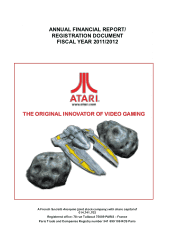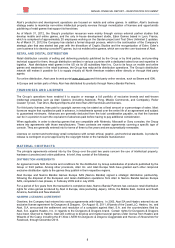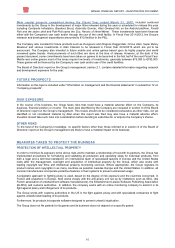Atari 2012 Annual Report Download - page 5
Download and view the complete annual report
Please find page 5 of the 2012 Atari annual report below. You can navigate through the pages in the report by either clicking on the pages listed below, or by using the keyword search tool below to find specific information within the annual report.
ANNUAL FINANCIAL REPORT – REGISTRATION DOCUMENT
5
building and monetizing Atari’s mobile and online games as well as developing its licensing operations, while remaining
opportunistic in the retail business. As a result, management decided to report its segments as digital, licensing, and
retail.
In addition, management of the Company decided, in conjunction with the Company’s evaluation of its segments, to
change the presentation of the “digital revenues”, and that the mobile and social portions of the “Digital” segment should
be reflected on a gross basis, with corresponding costs reflected in cost of goods sold. For purposes of presentation
consistency, the Company has restated FY 2010/2011 digital distribution revenues in the same manner, with no impact
to the gross margin or the rest of the P&L.
STRATEGY
The major development in Fiscal Year 2011/2012 was the accelerated building and monetization of Atari’s brand and IP
portfolio in the mobile and online game segments.
The Group’s strategy is constantly driven by four priorities:
1. BUILDING AND MONETIZING ATARI’S DIGITAL GAMES;
2. LEVERAGING ATARI’S BRAND AND IP PORTFOLIO THROUGH LICENSING AND STRATEGIC
PARTNERSHIPS;
3. REMAINING OPPORTUNISTIC ON THE RETAIL MARKET TO PROMOTE ATARI’S IP’S; and
4. FOCUSING ON PROFITABILITY
1. BUILDING AND MONETIZING ATARI’S DIGITAL GAMES
Atari’s strategy is focused on the digital segment, the fastest growing segment of the gaming industry, with a specific
focus on mobile games as a core business and also a re-focus on online games as part of cross platform initiatives. Not
only is this strategy deployed on all relevant mobile platforms, including smartphones, tablets, and other connected
devices, but also online via browsers, Facebook, online networks, and digital downloads.
At this stage, Atari’s games are being developed externally with selected third party game studios to contribute to a more
flexible and lower fixed cost organization. During Fiscal Year 2011/2012, Atari launched and or marketed:
Breakout Boost and Breakout Boost+ for iOS, which have generated more than 3 million downloads since it
launched in December 2011.
Atari’s Greatest hits for iOS and Android, which has generated over 6 million downloads and transactions
as of March 31, 2012.
The highly-rated Asteroid Gunner and Asteroid Gunner + for iOS, which have generated more than 1
million downloads and transactions since they were launched in November 2011.
Atari aims to develop higher-margin revenue streams on the mobile and online segments via:
Mobile gaming revenues generated from a mix of “freemium” monetization functionalities, premium offers
and advertising revenues. Freemium games are provided free of charge and consumers pay for advanced
features and functionalities, additional games and levels, and related products via micro-transactions;
Digital distribution revenues generated by Atari games or third-party games available on the Atari.com
digital store as well as on other third-party digital distribution platforms; and
Online and social gaming revenues generated through advertising and/or micro-transactions.
Atari’s digital strategy benefits from strong brand recognition, and is further driven by a web portal (www.atari.com) that
attracts, retains, and monetizes traffic. This site is a central hub for direct sales and community management. New Atari
games as well as Atari classics spanning the entire history of videogames (Pong, Missile Command, Asteroids, etc.) are
progressively released on Atari.com.
2. LEVERAGING ATARI’S BRAND AND IP PORTFOLIO THROUGH LICENSING AND STRATEGIC PARTNERSHIPS
Atari owns and/or manages a globally recognized corporate brand and portfolio of more than 200 games and franchises,
including Asteroids®, Centipede®, Missile Command®, Pong®, Test Drive®, Backyard Sports®, and Rollercoaster
Tycoon®. This unique portfolio of IPs and brands can further contribute to revenues through all type of licensing deals,
most notably through games, merchandising and other media.
During Fiscal Year 2011/2012, some specific products that leverage Atari classics included the launch of the Atari
Arcade gaming controller for the iPad, which was launched with its partner Discovery Bay Games. This partnership
enabled Atari to leverage its brand notoriety and enhance the game play experience on the Apple iPad.
3. REMAINING OPPORTUNISTIC ON THE RETAIL MARKET TO PROMOTE ATARI’S IPS
The retail games market is suffering from a very challenging economic environment. While Atari is focusing on the high-
growth mobile and online segments, retail has become more opportunistic and developed through potential profitable
deals or partnerships that derive maximum value from its large portfolio of intellectual properties.


















